- Home
- Robert J. Mrazek
Dead Man's Bridge
Dead Man's Bridge Read online
ALSO AVAILABLE BY ROBERT J. MRAZEK
FICTION
The Bone Hunters
Valhalla
The Deadly Embrace
Unholy Fire
Stonewall’s Gold
NONFICTION
To Kingdom Come
A Dawn Like Thunder: The True Story of Torpedo Squadron Eight
DEAD MAN’S BRIDGE
A JAKE CANTRELL MYSTERY
Robert J. Mrazek
NEW YORK
This is a work of fiction. All of the names, characters, organizations, places, and events portrayed in this novel are either products of the author’s imagination or used fictitiously. Any resemblance to real or actual events, locales, or persons, living or dead, is entirely coincidental.
Copyright © 2017 by Robert J. Mrazek.
All rights reserved.
Published in the United States by Crooked Lane Books, an imprint of The Quick Brown Fox & Company LLC.
Crooked Lane Books and its logo are trademarks of The Quick Brown Fox & Company LLC.
Library of Congress Catalog-in-Publication data available upon request.
ISBN (hardcover): 978-1-68331-269-7
ISBN (ePub): 978-1-68331-270-3
ISBN (ePDF): 978-1-68331-272-7
Cover design by Andy Ruggirello
www.crookedlanebooks.com
Crooked Lane Books
34 West 27th St., 10th Floor
New York, NY 10001
First Edition: August 2017
To Jim and Ann with love
Every guilty person is his own hangman.
—Seneca the Younger
Contents
Chapter 1
Chapter 2
Chapter 3
Chapter 4
Chapter 5
Chapter 6
Chapter 7
Chapter 8
Chapter 9
Chapter 10
Chapter 11
Chapter 12
Chapter 13
Chapter 14
Chapter 15
Chapter 16
Chapter 17
Chapter 18
Chapter 19
Chapter 20
Chapter 21
Chapter 22
Chapter 23
Chapter 24
Chapter 25
Chapter 26
Chapter 27
Chapter 28
Chapter 29
Acknowledgments
1
Her desolate moan dragged me back from the abyss. I could hear the spatter of hard rain against the cottage windows. A peal of thunder erupted above us as the storm slowly rolled east toward the Adirondacks.
She was trembling when I reached across the bed to stroke her back. As she labored to find a more comfortable position, she kicked me in the leg before falling back into a fitful sleep. The nightmares were coming more frequently now, and I wondered if the chemotherapy treatments were responsible.
Her oncologist had warned me that the chemo might cause serious side effects. But without the treatments, he said that the cancer would almost certainly metastasize. She had borne the injections with silent fortitude.
Her night breathing had become increasingly spasmodic. I remembered my awe at her physical agility and grace when she was young. It was hard to witness the toll the disease had taken on her energy and strength.
The first time I saw her was in a remote Afghan village beyond the Khyber Pass. It was early winter, and an old mujahideen had been about to disembowel her for his next meal. Back then, her thick coat had been pure white and she was as big as a calf. In spite of the indignity of being shackled to a rusty chain, there was a hint of royalty in her manner.
I asked the old man what kind of dog she was.
“Only Allah could be sure,” he growled in Pashto while continuing to sharpen his knife. “I think . . . half wolf . . . half deer.”
He might have been right. In quiet repose, her face was sweet and gentle, almost like a fawn’s. When her blood was up, she had the primeval glare of a timber wolf about to ravage its prey.
I gave the old man a gold sovereign and kept the dog. A few nights later, I was in the mountains and waiting for orders on the next raid. A cloud of flying insects had descended on our camp. As I sat close to the fire, the dog began leaping into the air with incredible speed to capture them in her mouth. That’s when I decided to call her Bug.
She was my closest companion for the next five months. Unlike a number of my human brethren, she was intelligent, loyal, and brave. On a frigid night near Kandahar, her growled warning had saved my life.
Another mournful sigh broke the stillness as lightning lit the sky. Through the window, I watched the bolt strike the earth on the other side of the lake. My father used to call it the finger of God.
I knew I wouldn’t get back to sleep. Trying not to disturb her, I walked through the open French doors and out to the wraparound porch. Standing in the darkness, I inhaled the smell of wet moldering leaves. A few days of raw October wind had stripped them from the trees and left them a couple inches deep on the grass leading down to the lake.
I heard Bug drop from the bed to the floor, and she slowly came through the French doors. Her eyes were like two chocolate moons in the jagged white face, her rear legs quivering. In the years we had been together, her white coat had gone increasingly gray.
She had been as fast a dog as I have ever seen. Now she couldn’t walk from the bedroom to the kitchen without panting. My veterinarian’s best guess was that she was eighteen years old.
I went back to the kitchen and picked up the open bottle of Johnnie Walker on the counter. I emptied a couple of fingers into her water bowl. She lapped at it contentedly until her left hind leg began quivering again. Moving over to the rug by the fireplace, she flopped down onto her stomach and began licking her front paws.
I sat in the Morris chair on the porch and took a hit of scotch. There were three hours to kill until dawn. A shaft of moonlight emerged from the low silvery clouds.
The night air felt close. It reminded me of the hurricane seasons when I was stationed at Fort Benning in Georgia.
“Heavy weather on the way,” I said to Bug while rubbing my knees. She looked up at me with her luminous chocolate eyes before flopping onto her side and letting out another low moan.
I considered my own bout with melancholy. The first psychiatrist the army had assigned me during my court-martial had concluded that I was depressed. No medical training was required to figure that out. I had killed eleven men in Afghanistan, and three of them were on my own special operations team. A night doesn’t go by that they don’t visit me, their mutilated dead faces in full Technicolor.
The psychiatrist assured me that my depression was pathological and that it could be cured with psychotropic drugs. He was a born-again Christian and strongly recommended that I also let his Savior into my life.
A second psychiatrist was assigned as part of the legal team defending me on the murder charges at my court-martial. She arrived at the same conclusion as the first one: I was depressed. Unlike the first shrink, she told me that depression was part of human nature, a gift to us ever since the Romans worshipped the god Saturn.
“Whenever you feel depressed, Major Cantrell,” she said after our first session, “welcome Saturn into your heart . . . embrace him like an old friend.”
I took another swallow of Johnnie Walker. After its fiery glow receded in my throat, I picked up a book from the stand next to the Morris chair. It was an old friend of mine, a pulp fifties paperback by John D. MacDonald. Between swigs, I tried to get through the first page.
I thought about the army-issue 1911 Colt .45 that was sitting in the hollowed niche next to the chimney. O
ver the years, the handgrips had been worn smooth. It would be so simple. A swift pressure of finger on trigger and the familiar whiff of cordite. Why not make my final count an even dozen?
The jarring ring of the landline telephone came through the open porch doors. I decided not to answer. It kept on ringing, and I made a mental note to put in a voice mail message if I was still around on Monday. After a dozen rings, I got angry. Whoever was calling had obviously decided to let it ring forever. I went into the living room and picked it up.
“Officer Cantrell?” came the timid voice. It sounded hoarse and urgent. “This is Carlene.”
“I know,” I said, recognizing her voice.
Carlene was one of the new provisional campus security officers and worked as a dispatcher on the midnight shift.
“You’re needed here right away,” she said.
“What time is it?”
“A little after five.”
“My shift doesn’t start until eight, Carlene.”
“I know, but . . . this is an emergency.”
Emergencies were rare at St. Andrews College. Our most recent one involved a female student majoring in pre-wed. After getting jilted by the captain of the hockey team, she had swallowed a handful of amphetamines and run amok at the Kappa Kappa Gamma sorority. I asked Carlene if the girl had escaped from the county hospital.
“That isn’t funny,” she said, her voice rising. “You’re needed here right away.”
Carlene always seemed to be on the verge of tears. I recalled one of the other officers telling me that she was undergoing grief counseling after breaking up with her own boyfriend.
“An individual just called in from one of the blue emergency boxes to report that we have a deceased male individual on the campus,” she declared with the kind of quasi-official jargon mandated by Captain Janet Morgo, the chief of the campus security force.
Bug had followed me inside and was glaring at the phone as if she resented the intrusion as much as I did.
“It’s probably a prank,” I said.
“I don’t think so,” she replied, her voice getting shrill. “It was a man on the phone. He hung up before I could ask him anything else.”
“Why not call Captain Morgo?” I came back, not wanting to drive into town after draining half a bottle of scotch.
That’s when she blew.
“I hate this job!” she shouted into the phone. “Why am I always left here alone at night?”
“Calm down, Carlene,” I said.
“Do you think I would be calling you if there was anyone else to handle this?” Carlene yelled. “Captain Morgo is on the road back from the conference in Albany, and I can’t reach her on her cell phone. Lieutenant Ritterspaugh is having contractions, and Officer Hurd is on vacation in New Mexico. You’re the fourth-ranking officer in the department.”
Her tone suggested that the sacred trust had been left in the hands of the Boston Strangler.
“All right, sweetheart. Where is this body supposed to be?”
There was more exasperated breathing before she said, “The caller told me that the deceased individual was hanging from the suspension footbridge over the Fall Creek Gorge. In a few hours, it will be in plain sight of the alumni arriving for homecoming weekend.”
“Call the sheriff’s office,” I advised.
“I can’t do that,” she objected. “After the last student incident on the bridge, Captain Morgo implemented a strict policy of campus police being the first responders.”
In May, an Asian American honors student had committed suicide by jumping off that same bridge. It had ended up as a feature story in the New York Times. Bad for college recruitment.
“Call the sheriff’s office, Carlene,” I repeated in what I hoped was a reassuring voice. “I’m on my way.”
2
I drove into Groton along the gravel road next to the lake. My old Chevy pickup rattled in mortal agony as I held it to fifty on the rough surface. Bypassing the town square, I headed up Campus Hill on the steep grade that bordered the Fall Creek Gorge.
Off to my right, a two-hundred-foot-high cataract of black water was cascading down the raw sandstone canyon. Thirty thousand years ago, a glacier had retreated through this part of upstate New York like a giant plow, carving out the bedrock and leaving deep gorges in its path.
This chasm separated the campus of St. Andrews College from the residential neighborhood that adjoined it. In the 1930s, President Roosevelt’s WPA had constructed a suspension footbridge across the gorge to connect the two.
Rooming houses, fraternities, and sororities dotted the residential side. Most of the college kids living in the neighborhood used the footbridge as a shortcut to reach the academic quad. Unfortunately, the bridge had also become a magnet over the years for stressed-out students looking to put an end to more than their academic careers.
As I continued up the steep grade in first gear, the Fall Creek Tavern emerged out of the gloom. Called the Creeker by the locals, it clung to a shale plateau next to the road, the rear wall sagging out over the two-hundred-foot abyss. The Creeker’s regular closing time was four AM. Through the open front door, I could see a barmaid sweeping the cracked linoleum floor.
Ben Massengale was standing under the side portico, smoking a cigarette and waiting for the place to reopen at six. He waved at me and smiled, exposing his dire need for advanced dentistry. I waved back.
The grassy overlook next to the footbridge had six parking spots. They were all occupied. The college enforced a one-hour time limit on the spaces, and I saw that all but one had been ticketed for an overnight parking violation. The unticketed car was a vintage Saab station wagon with a peeling bumper sticker that read, “Save the Arctic.”
Dawn was paling the eastern sky as I parked my truck at a steep angle ten feet from the precipice of the gorge and next to the brick path that led to the bridge. Taking my police badge out of the glove compartment, I pinned it to the chest of my blue pullover. Grabbing a flashlight and a pair of clean cotton work gloves, I slid over to the passenger side and leaned hard against the badly sprung door.
I was almost through the opening when the wind whipped it back, and the door slammed into my kneecap. A jolt of pain raced up my right leg. Waiting for it to subside, I took a few moments to scan the bridge.
From end to end, the steel span was about fifty yards across. Its walkway was six feet wide and covered with poured concrete. Five-foot-high iron railings bordered each side. The space beneath the railings was covered with steel mesh to prevent an accidental fall.
I could see something slowly swaying in the darkness halfway across the bridge and directly underneath it. What might have been a body was hanging from a rope about ten feet beneath the walkway. My first thought was that it could be an elaborate hoax, a fraternity prank to welcome the alumni back for homecoming weekend.
Limping past the parked cars, I touched the hood of the unticketed Saab. It was cold, but I made a mental note of the license plate number. In the glare of the flashlight, I could see a raw gouge in the paint on the rear fender. It looked as if someone had scored the paint with the head of a screwdriver. The gouge extended around the side of the car. Training the flashlight beam on the adjacent car, I saw that its door panels had been scored the same way.
As I hobbled down the brick path to the bridge, I wondered why the county sheriff’s office hadn’t already dispatched a patrol car to the scene. They would have been there before me if Carlene had phoned them after I hung up. I decided to call in from the emergency phone at the entrance to the bridge.
The blue emergency light above the telephone was haloed in mist. Flipping open the door of the metal housing, I found a bare wire. Its copper ends had been cut. I remembered Carlene saying that the man had called from an emergency phone. This was the only one in the area.
An owl called out in the elm tree above me. Otherwise, the only sound was the rush of water down the gorge. The houses along the street were dark. I glanc
ed over to the other side of the bridge. Nothing moved in my line of sight.
Putting on the work gloves, I paused at an engraved plaque that was bolted onto the stanchion at the entrance to the bridge. “This facility was painted through the generosity of Arnold Rhatigan, ’73,” it read. Similar plaques adorned the campus like chrome dandelions.
As I headed out across the bridge, I swept the walkway ahead of me with the flashlight. The surface was wet from rain. It was unmarred. Halfway across the span, I came upon a length of rope strapped around the left railing. It had been secured with a simple stopper hitch. The rope was an inch in diameter, and the end of it was braided into four different-colored strands. The tip was capped with what looked like a golden acorn. There was something vaguely familiar about it.
My eyes were drawn to several objects on the concrete walkway. A thin booklet lay against the foot of the railing beneath the rope. The cover was green and gold with black lettering that read, Your St. Andrews Welcome Home Alumni Guide.
Beneath the words was a color photograph of the footbridge I was standing on that had been shot in autumn sunshine with the maple trees ablaze in the background. Pinned to the booklet was a plastic name tag. “Dennis Wheatley” was written in black calligraphy. A green plastic reunion mug sat next to the booklet. There were a couple of inches of liquid remaining in it. I recognized the aroma of blended whiskey.
I leaned out over the five-foot-high railing. Two hundred feet below, the cataract of water tumbled down the rock-strewn gorge. About ten feet below me, the large object was swaying back and forth at the other end of the braided rope. The flashlight beam brought it into clear view.
It was no hoax. He was real.
The dead man was wearing a blue-and-white-striped seersucker suit with white penny loafers. One of them had apparently dropped off. He wasn’t wearing socks. A green reunion baseball cap was still stuck on his head, the bill skewed to the side. Ringlets of grayish-blond hair spilled out below the lower edge. From the angle where I was standing, I couldn’t see his face.

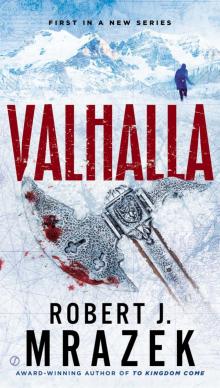 Valhalla
Valhalla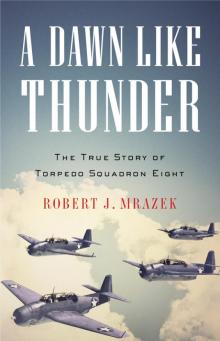 A Dawn Like Thunder
A Dawn Like Thunder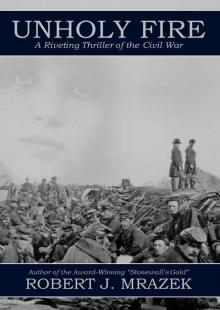 Unholy Fire
Unholy Fire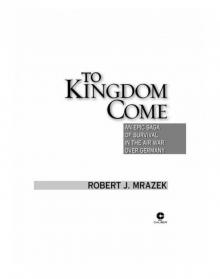 To Kingdom Come
To Kingdom Come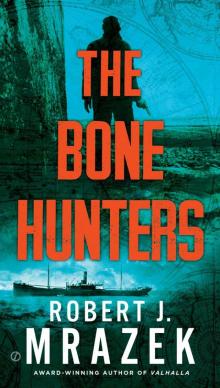 The Bone Hunters
The Bone Hunters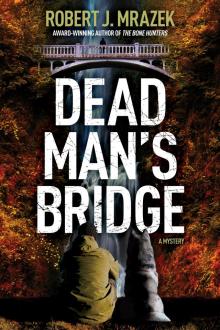 Dead Man's Bridge
Dead Man's Bridge